Day Two
Having had late dinner last night, we got
late breakfast this morning – more time to sleep! We were up at 8:15
a.m. on this Saturday. Jim immediately put Sounds of the 60s with Brian
Matthews on the radio as we prepared for the day. There was a mist
covering Ben Lomond and the other Bens across the loch. We also could
see the Loch Sloy power station, the UK’s largest conventional
hydroelectric power station, with four large pipes running up the hill
behind the building. It takes water from Loch Sloy at the top of the
mountain and uses the water to power the large turbines inside the
building to create power for Clydeside and Central Scotland during peak
times, and a full capacity can be achieved in less than 5 minutes. Loch
Sloy is dammed to hold the water and is fed by a series of tunnels and
aqueducts from a larger area. The station was opened in 1950 by the
Queen Mother and refurbished in the late 1990s at a cost of £113
million. It can produce 160 megawatts of power.
The mountains appeared then disappeared in
the mist which we could visibly see moving past our window. The sun came
out briefly and reflected the mountains on the water. We saw a lot of
fabulous reflections on the water of the lochs as we travelled around
Scotland on this tour. Loch Lomond is 30 metres above sea level and is
approximately 25 miles long and 5 miles wide at the widest point on the
southern end of the loch. It is 600 feet deep in places.
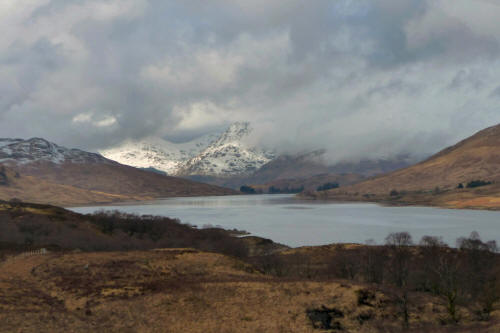
We had our breakfast at 9:10 a.m. and were
at the coach at 10:10 a.m. for departure. There is a waterfall at the
side of the Inversnaid Hotel. From here Wordsworth got the idea for his
poem “To A Scottish Maid.” As we drove out along The Motorway, Kevin
told us the area is all part of the Inversnaid Reserve. We saw many wild
goats as well as the highland cattle or Heiland Coos as they are known.
Wild rhododendrons grow along the road and up into the forested areas.
Snade Burn rushes over rocks and boulders and makes a picturesque scene
at the side of the road. Kevin shared many local stories along with the
history as we road past Arklet Dam and Loch and on to Loch Katrine,
where we stopped to take photos. Many of the conifers around the lochs
looked dead, but Jim assured me they were European larch trees, the only
conifers that turn brown in the winter.
We stopped by the Stronachlacher Lodge for
photos near the McGregor cemetery. There is a tearoom at the edge of the
loch. The sun came out for a short time. As we drove along, I noted the
large tufts of brown grass that will later in the year be a rich green.
The highlands look so different this time of year with their varying
shades of tan and brown and the almost black of the heather that will be
lovely shades of lavender in August and September. The ferns and bracken
were wilted in the winter weather and lay folded over upon themselves,
later to perk up and unfurl new shoots and turn a lush green. We passed
Loch Chon and I continued to notice the countryside with lichen on the
trees and rocks, moss around tree trunks and stones, burns (streams)
running over rocks and tree roots, and many waterfalls in many different
sizes and force coming down the mountains. It feels like a magical area
even in March. We passed Loch Ard and the Forest Hills Hotel. The
daffodils have buds but they haven’t opened yet this far north.
Everything is just so beautiful – nature is wonderful!
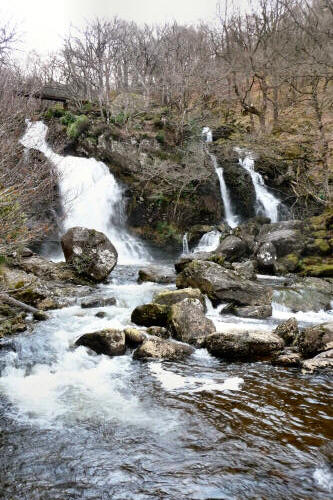
Low stone walls surround stone houses in
picturesque settings. We passed the source of the River Forth, much
smaller in this part of the country than it is near Edinburgh. When we
stopped at the Scottish Wool Centre in Aberfoyle, Jim didn’t want to
shop, so we walked the main street of the small village before having a
drink in The Forth Inn. I visited this centre on the tour of Scotland
when I met my husband in June 2000 (article of the tour on this site). I
photographed a strange fluffy chicken outside the building. We crossed
the Duke’s Pass, referring to the Duke of Montrose, when we got on the
road again, and entered the area of the Trossachs National Park. Ospreys
can be seen here April to September, but we were too early for them. In
May the bluebells carpet the woods with their brilliant color.
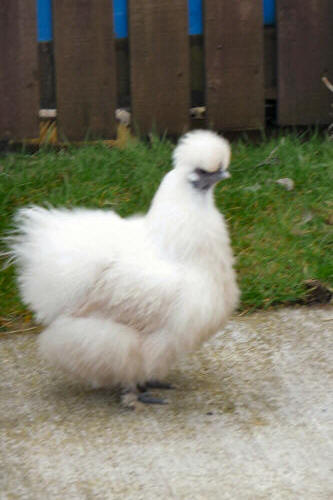
There used to be slate mines in this area
and the broken pieces of slate can still be seen at the roadside. We
were on Three Loch Drive where three small lochs dot the landscape. One
of the lochs is Loch Drunky. Whisky (comes from ‘uisge beatha’ meaning
the water of life – spelled without an ‘e’ in Scotland) was secretly
made near the loch in times past. To warn those making the illicit brew
that the government officials were near, a piper on a hill would play
during the day but play faster and faster if the officials came near so
the men at the still would have time to hide the evidence of their
activities. One night the piper fell asleep and didn’t play until it was
almost too late. When he did play, it was too late to hide everything,
so the whisky had to be dumped in the loch – hence, the name Loch Drunky.
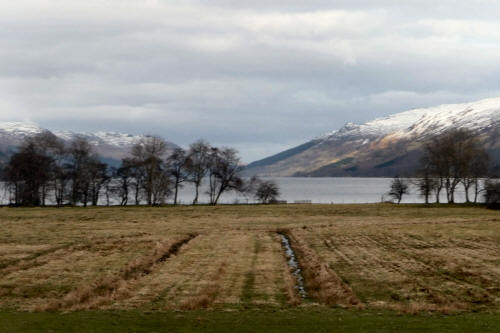
By this time, it was time for a comfort
break and lunch at another Lochs and Glens hotel, The Loch Achray Hotel.
We were told by a reliable source that this hotel has the largest midges
in the highlands as the weather warms up. Fresh salmon sandwiches and
salad were available for £4.95. It also was possible to order a hot meal
in the restaurant or choose from several other sandwich types. Jim is
allergic to salmon and I don’t care for fish, so we chose ham and tomato
sandwiches. We sat outside overlooking the loch but Jim was up and down,
playing with his radio with headset, trying to get his Tottenham Hotspur
football (soccer) game on the radio. Another Lochs and Glens coach was
running half an hour ahead of us, so he hitched a ride on it to reach
Callender ahead of us. He just knew there must be a pub showing the game
on the big screen! I stayed with our coach.
_small.jpg)
On the way to Callender, we passed numerous
small lochs then crossed the fault line back into the lowlands. On the
way, we saw 15-year-old Hamish and his wife, 3-year-old Heather, with
their young baby – Heiland coos all! The main street of Callender is
long and wide with shops on both sides. The name Waverley had been
mentioned as a possible place for the football game to be on. I walked
to the far end of the street and found the Waverley Hotel but no Jim. I
asked if anyone had been in asking for the English football game. No one
had. They were all watching rugby. I walked back up the street going in
Pringle’s Woolen Shop then into Tourist Information to see what they
had. As I reached the end of town where I had begun, this end overlooked
by a snow-capped mountain, I looked into the Crown Hotel and saw Jim
sitting on a high stool watching sports. The football game was over, and
the Tottenham game had finished in a draw, which frustrated him greatly.
After I had rounded him up, we walked across the street for afternoon
tea before walking back toward the coach. Jim thought of something he
had to get from Tourist Information and was quickly off down the street.
He always managed to be the last on board the coach, although he claimed
he was on time to the minute each time.
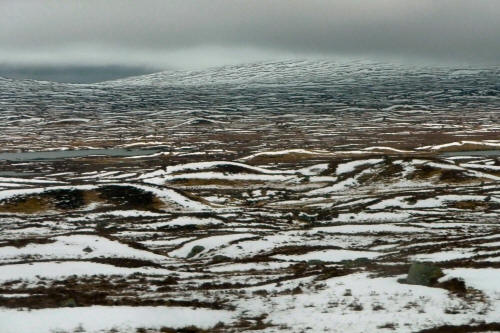
It had turned cloudy and cold by now. We
drove through another area of water running over rocks in burns and
waterfalls, long and short, and drove along Loch Lubraig. There were
camping areas along this stretch of road with tents and caravans in
different places. I saw snowdrops blooming here and there. We passed
Strathyre. Kevin told us a strath is a wide u-shaped valley and a glen
is a narrow v-shaped valley. We came to Balquidder, where Rob Roy spent
his last years and where he is buried. The road to the grave is not
suitable for coaches as there is nowhere to turn around, so we didn’t
make a stop here. This is Argyll and Clan Campbell territory. Next came
Lochearnhead at the head of Loch Earn. We saw a Scout camp near here and
just past that some sheep wandered onto the road. This is called a
highland traffic jam! In the region of Glen Ogle, a Roman legion was
stationed many centuries ago and spent 40 years here. When we reached
Crianlarich, the discussion turned to the railway and all of the lines
that were closed in the 1960s by the infamous Dr. Beeching, making it
difficult to reach many parts of Britain easily. Some lines have been
and are being restored, but many can never be restored as other things
have been built in their place. There is a railway station in
Crianlarich with one line going to Glasgow and another going to
Inverness. The next village was Ardlui with its Green Welly Shop where
Jim once bought his favourite pair of hiking boots. They have now lost
their soles and he still refuses to throw them away! I live in fear that
they will end up on the mantelpiece some day with flowers in them.
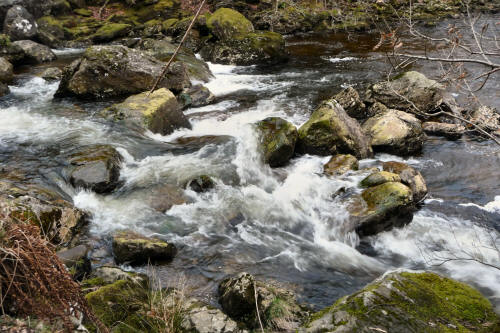
We pulled into the viewpoint at Inveruglas,
where the coaches park overnight, then boarded the Inversnaid Hotel
ferry which took us across the loch to the hotel. We had late dinner again
so had some time in our room, nearly falling asleep as we watched the
news on TV. We did make it to dinner on time then to the function room
for the evening’s entertainment. Another singer/comedian played music
and talked, and many people got up to dance. There had been a quiz sheet
at the reception desk this morning. I hadn’t realized Jim had turned
mine in, so when I was announced as the winner of the quiz, I was
somewhat startled and embarrassed. I won a bottle of sparkling perry!
